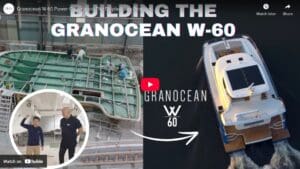Weather Forecasting for Sailing Without Instruments
When talking about weather, the sinking of HMS Bounty in the Atlantic a few week ago during hurricane Sandy, is foremost in my mind. The three-mast, 180-foot ship, HMS Bounty, built for the 1962 movie “Mutiny on the Bounty,” sank in the Atlantic after water pumps apparently failed and they lost all propulsion. In the case of the Bounty and Hurricane/Superstorm Sandy, we knew at least a week or more ahead of time that this storm would be a weather event to be reckoned with. That is why it is so curious that the captain of the Bounty decided to “skirt” the storm from Connecticut to Florida. The captain is a well-respected seaman and his decision obviously was calculated but ultimately fateful. I don’t want to second guess him here and I am sure that we will discover the reasoning behind this decision but all be warned, the ocean can be as treacherous as it can be beautiful!
With the tragic loss of the HMS Bounty, I am reminded of the voyage that we did on Royal Salute as we set off from Cape Town harbour, on the first leg of our cruise around the world in 1992. Similar to the Bounty, we too were trapped in a “superstorm” off the coast of Cape of Good Hope, the worst storm in living memory. We were on our way to Port Elizabeth on the East Coast of South Africa and got caught in this storm with 200m/h winds and 30ft seas bouncing off the continental shelf (a trip that should have taken about 8 hours turned out to be 48 hours). After nearly capsizing twice (the top of the mast almost touched the waves) we made it into the harbor…battered, bruised, soaked, and decidedly shell-shocked.
Stephen was the only experienced guy on board and he thankfully got us through the storm safely. But that was a huge lesson for us. We were victims of our own inexperience, limited resources, and not trusting our own instincts and senses. Today, weather forecasting is so far advanced and one can do fairly accurate planning for a crossing. By studying the forecast carefully, being mindful of seasonal weather patterns and relying on your senses and observations, one can play out all possible scenarios when planning. Once out there and things do not quite work out the way you have planned, try and run with the weather. There is no shame in turning back, that is, if there is somewhere to turn back to, which in our case there was not. The harbors were closed to incoming traffic, something that has not happened before, so we had to tough it out.
That brings me to the subject of weather forecasting without instruments. Sailors should understand seasonal weather patterns in their area and be able to read signs in the environment both before and during a trip: the wind, sea state, clouds, appearance of celestial bodies, smells contain clues to current and approaching weather. The art of non-instrument weather forecasting can be used to confirm weather reports or to predict weather when instruments and reports are not available. Following here are the things that any sailor can observe in nature to use as an indication of weather in his/her area and take appropriate precautions.
Beaufort Scales (Wind Speed)
| Force | Speed | Name | Conditions at Sea | Conditions on Land | ||
|---|---|---|---|---|---|---|
| Calm | Sea like a mirror. | Smoke rises vertically. | ||||
| Light air | Ripples only. | Smoke drifts and leaves rustle. | ||||
| Light breeze | Small wavelets (0.2 m). Crests have a glassy appearance. | Wind felt on face. | ||||
| 8-11 | Gentle breeze | Large wavelets (0.6 m), crests begin to break. | Flags extended, leaves move. | |||
| Moderate breeze | Small waves (1 m), some whitecaps. | Dust and small branches move. | ||||
| Fresh breeze | Moderate waves (1.8 m), many whitecaps. | Small trees begin to sway. | ||||
| Strong breeze | Large waves (3 m), probably some spray. | Large branches move, wires whistle, umbrellas are difficult to control. | ||||
| Near gale | Mounting sea (4 m) with foam blown in streaks downwind. | Whole trees in motion, inconvenience in walking. | ||||
| Gale | Moderately high waves (5.5 m), crests break into spindrift. | Difficult to walk against wind. Twigs and small branches blown off trees. | ||||
| Strong gale | High waves (7 m), dense foam, visibility affected. | Minor structural damage may occur (shingles blown off roofs). | ||||
| Storm | Very high waves (9 m), heavy sea roll, visibility impaired. Surface generally white. | Trees uprooted, structural damage likely. | ||||
| Violent storm | Exceptionally high waves (11 m), visibility poor. | Widespread damage to structures. | ||||
| Hurricane | 14 m waves, air filled with foam and spray, visibility bad. | Severe structural damage to buildings, wide spread devastation. | ||||
Sail With Us to Learn


Week-Long Liveaboard Courses
Rare RYA Classes & Certifications
Catamaran Guru’s real-life practical methods combined with up-to-date sailing theory in lessons aboard recent model catamarans…or your own boat!
Prepare for certifications or take the first step aboard to embark on your dream life of boat ownership or cruising
Classes in S Florida and the Bahamas.






